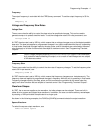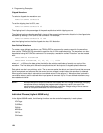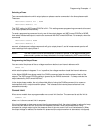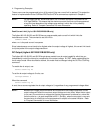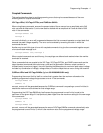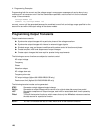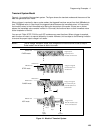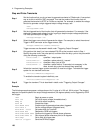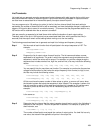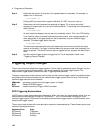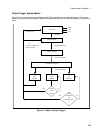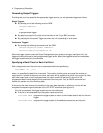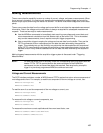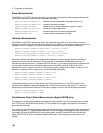Programming Examples - 4
131
List Transients
List mode lets you generate complex sequences of output changes with rapid, precise timing, which may
be synchronized with internal or external signals. Each function that can participate in output transients
can also have an associated list of values that specify its output at each list point.
You can program up to 100 settings (or points) in the list, the time interval (dwell) that each setting is
maintained, the number of times that the list will be executed, and how the settings change in response to
triggers. All list point data is stored in nonvolatile memory. This means that the programmed data for any
list function will be retained when the ac source is turned off.
Lists are paced by a separate list of dwell times which define the duration of each output setting.
Therefore, each of the up to 100 list points has an associated dwell time, which specifies the time (in
seconds) that the output remain at that setting before moving on to the next setting.
The following procedure shows how to generate a simple list of voltage and frequency changes.
Step 1
Set the mode of each function that will participate in the output sequence to LIST. For
example:
VOLTage:MODE LIST
FREQuency:MODE LIST
Step 2
Program the list of output values for each function. The list commands take a comma-
separated list of arguments. The order in which the arguments are given determines the
sequence in which the values will be output. For example, to cycle the voltage through a
sequence that includes nominal line, high line, and low line, a list may include the following
values:
LIST:VOLTage 120, 132, 108, 120, 132, 108, 120, 132, 108
You can specify lists for more than one function. For example, to synchronize the previous
voltage list with another list that varies the output frequency from nominal, to high, to low,
the lists may include the following values:
LIST:VOLTage 120, 132, 108, 120, 132, 108, 120, 132, 108
LIST:FREQuency 60, 60, 60, 63, 63, 63, 57, 57, 57
All lists must have the same number of data values or points, or an error will occur when
the transient system that starts the sequence is later initiated. The exception is when a list
has only one item or point. In this case the single-item list is treated as if it had the same
number of points as the other lists, with all values being equal to the one item. For
example:
LIST:VOLTage 120, 130, 140, 150;FREQuency 60
is the same as:
LIST:VOLTage 120, 130, 140, 150
LIST:FREQuency 60, 60, 60, 60
Step 3
Determine the time interval that the output remains at each level or point in the list before it
advances to the next point. The time is specified in seconds. For example, to specify five
dwell intervals, use:
LIST:DWELl 1, 1.5, 2, 2.5, 3
The number of dwell points must equal the number of output points. If a dwell list has only
one value, that value will be applied to all points in the output list.



